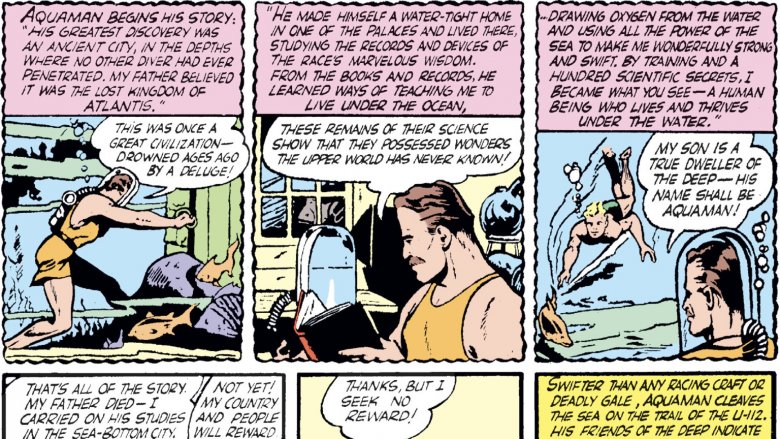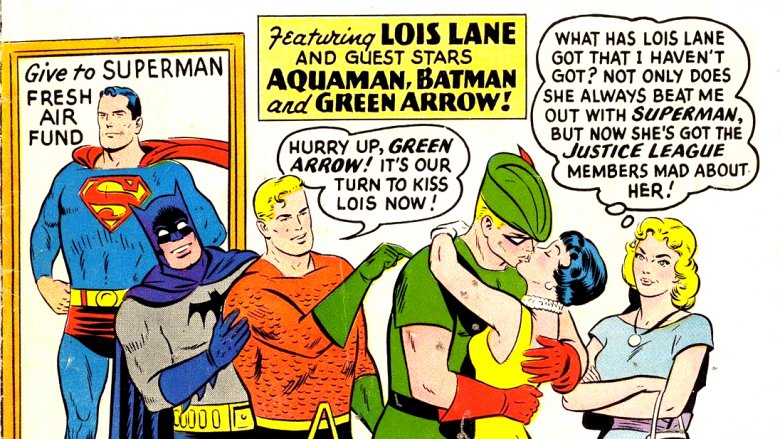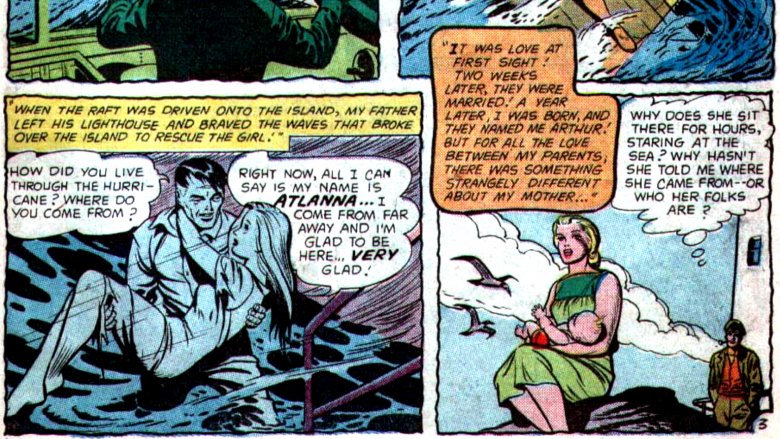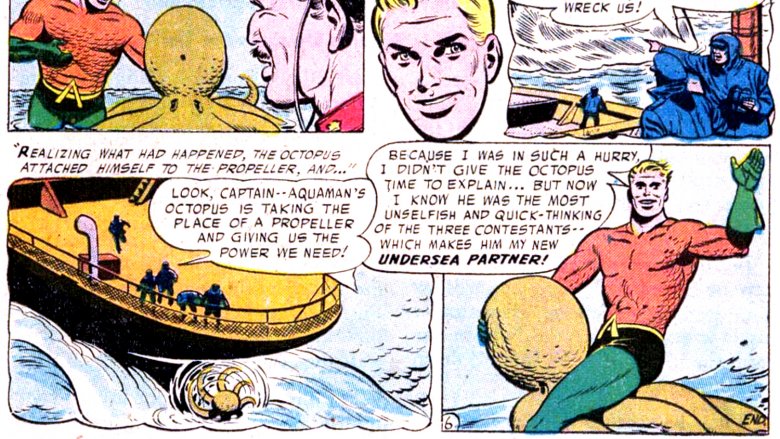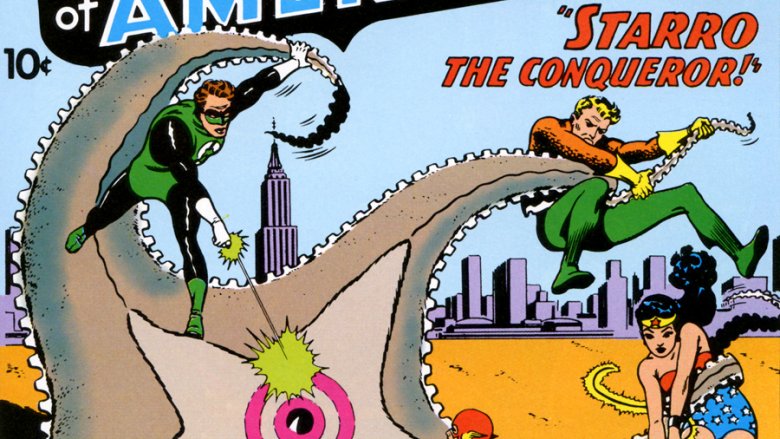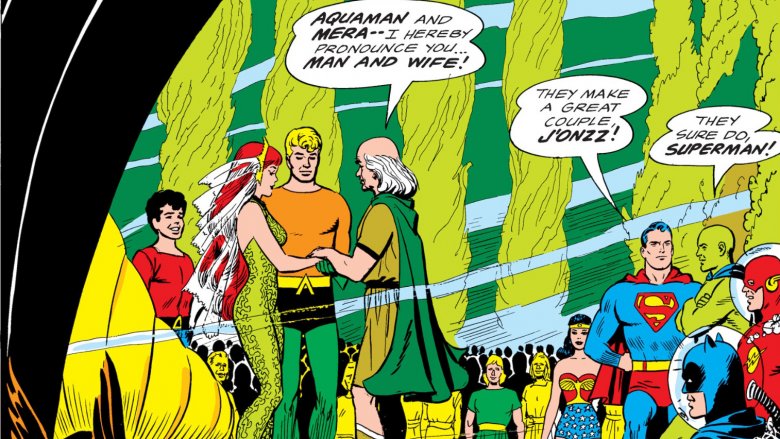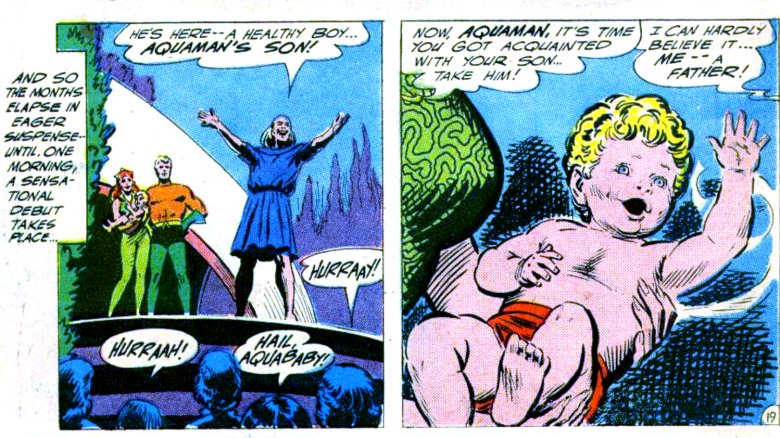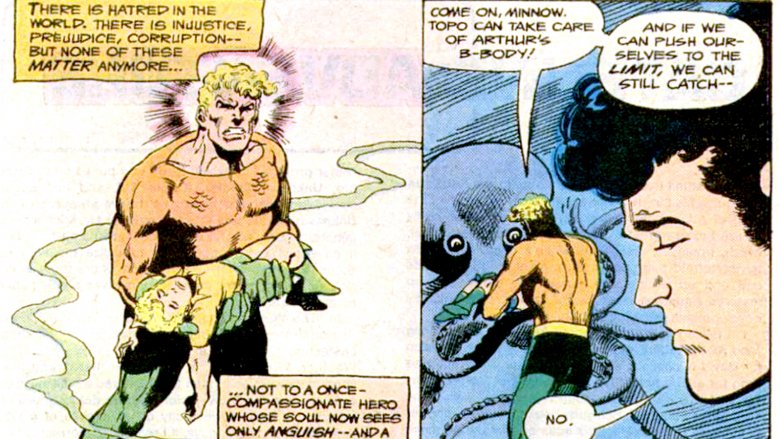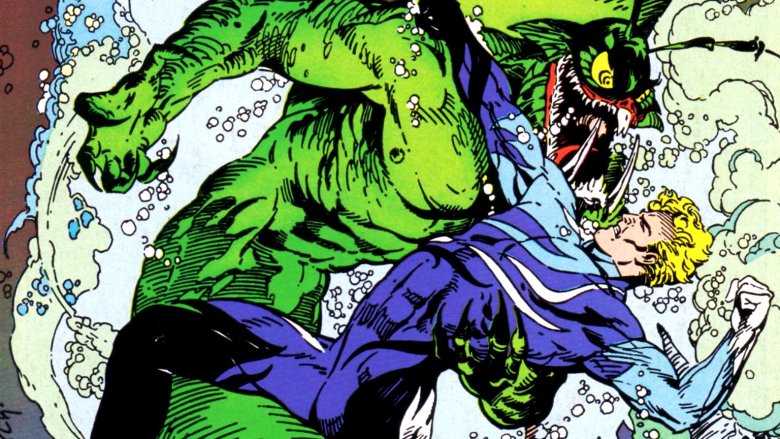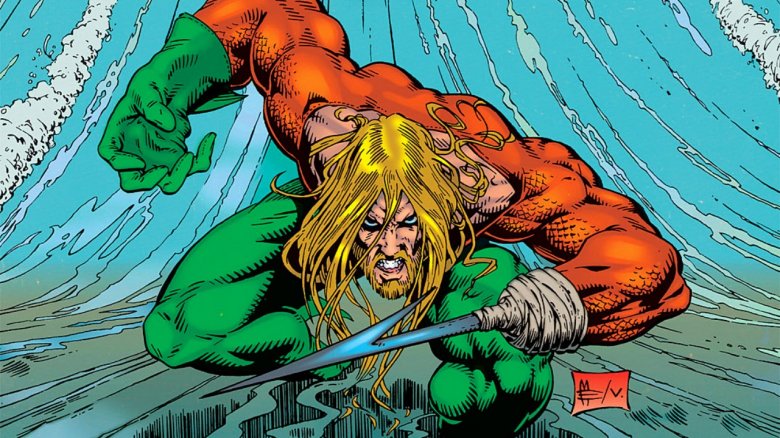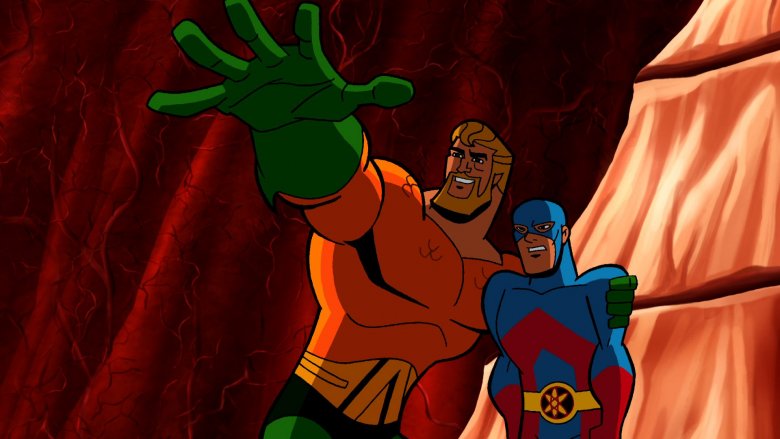The Untold Truth Of Aquaman
Who is Aquaman? If you've seen Justice League, you know him as Jason "Khal Drogo" Momoa. If you grew up watching Superfriends, you remember him as the blond guy in an orange shirt who didn't usually have much to do. If you've encountered internet humor in the past 20 years, you've probably heard that he talks to fish. However, Aquaman's been around in DC Comics for 77 years, and there's a lot about his history that you may have missed. Although he started as a very minor DC character, he rose to the top and starred in some groundbreaking stories along the way. More than just a superhero, he's been a king, a husband, a father, an amputee, and an exile. Here's a brief tour of some of the most important moments in Aquaman's long history, to give you more perspective on who he is and why he matters, as we all await the release of his upcoming solo film.
He had a completely different origin, originally
Everybody knows that Aquaman's from Atlantis, but in his first appearance in 1941's More Fun Comics #73, that wasn't the case at all. As he relates in flashback in that story, his father was a world-famous undersea explorer and researcher. Aquaman's mother died when he was a baby, and his father took him to live under the sea, in a water-tight building that was part of a long-abandoned city under the sea that he'd found. Using the ancient science of that forgotten civilization, he raised Aquaman to live comfortably under the sea, down to breathing water and talking to sea life. So this version of Aquaman isn't Atlantean at all, although he was raised in a deserted city that might have once been Atlantis. It was only later stories that made Aquaman first Atlantean and then the heir to the Atlantean throne. In the 1940s he was simply too busy fighting Nazi U-boat captains to have that complex a backstory. Fighting Nazis gave a huge number of costumed heroes plenty to do, but once that battle was over, the superhero craze started to die down.
He's one of only five DC superheroes to survive the 1950s
Superheroes fell out of favor in the late 1940s, and didn't really come back into vogue until the late 1950s. During this period, most superhero comics changed formats or ceased publication. Popular characters like Captain America, Flash, and Green Lantern disappeared from newsstands. When the DC heroes reappeared, they were revamped for the space age. Flash, Green Lantern, Atom, and Hawkman all got new secret identities and origins that made them more sci-fi in their focus. Naturally, DC's three most popular characters — Superman, Batman, and Wonder Woman — never lost their spots, but it's more surprising that a couple of also-rans from the back pages of Adventure Comics also managed to stick it out: Green Arrow and Aquaman.
It's probably not unrelated that Aquaman and Green Arrow were both created by Mort Weisinger (Aquaman with artist Paul Norris, and Green Arrow with George Papp), who went on to become the editor of Adventure Comics, so it was to some degree his decision to keep them around. Besides that, a modern day Robin Hood and a guy who lives in the ocean are certainly perfect for the "adventure" theme. Aquaman in particular was very strong in the '50s, with art by Ramona Fradon and plenty of sci-fi weirdness and sea creatures doing tricks.
His parentage always has been an evolving mystery
Even though Aquaman didn't disappear and have to be rebooted like so many other DC heroes of the time, he still got a new origin, and by extension a new identity. Adventure Comics #260 established that Aquaman was the son of a lighthouse keeper named Tom Curry and a mysterious woman who came from the sea named Atlanna. On her deathbed, Atlanna revealed herself as an exile from Atlantis, and that their son Arthur had inherited her aquatic powers. Thus Arthur Curry became Aquaman, and Aquaman, in a larger sense, became Arthur Curry for the first time.
Later stories would establish that Atlanna was a Princess of Atlantis, making Arthur Curry the heir to its throne. In 1989's Aquaman Special #1, this origin was revised again so that Aquaman was born to Atlanna in Atlantis, left to die in the open ocean as an infant, and later adopted by the lighthouse keeper after being cared for by dolphins for several years. In 1990's The Atlantis Chronicles, Peter David and Esteban Maroto introduced the ancient Atlantean wizard Atlan, who turns out to be Aquaman's biological father.
Exactly who Aquaman's parents were and how he was raised has changed quite a few times over the decades, but the basic idea that he came from the sea and was raised by a lighthouse keeper has stuck to the character pretty strongly since Adventure Comics #260 in 1959.
His original sidekick was an octopus
Most people remember Aquaman's sidekick as Aqualad, a dark-haired teen in red and blue. Aqualad first appeared in 1960, but Aquaman met his first lasting ally years earlier, in 1956. In Adventure Comics #229, Aquaman is inspired by a Canadian Mountie's relationship with his horse (really!), so he holds a contest to see which sea creature should become his sidekick. A swordfish and a whale both put on a strong showing, but the octopus competitor turns out to be much cleverer than he initially seemed, making him the winner. Most 1950s stories didn't lead to even the slightest change in the status quo, but Topo the octopus really did stick around to become Aquaman's most trusted helper. Since Aquaman's solo adventures pretty much all take place at sea, an octopus has more to contribute than you might expect. Even after Aqualad came on the scene in Adventure #269, Topo stuck around as a member of the supporting cast.
He didn't rise to prominence until joining the Justice League
You've almost certainly seen the cover to The Brave and the Bold #28, the first appearance of the Justice League of America. It features Green Lantern, Flash, Martian Manhunter, Wonder Woman, and of course Aquaman, all fighting a giant starfish who the cover copy identifies as Starro the Conquerer. Now here's what you might not know: that first Justice League cover where they're fighting Starro is the first time Aquaman ever appeared on a comic book cover.
Sure, Aquaman had been around for nineteen years, but he'd never had his own comic. Superboy had been the cover feature on Adventure Comics for as long as he and Aquaman had been featured in the book. Before that, Aquaman was overshadowed by Green Arrow in the pages of More Fun Comics. Being a minor hero whose adventures were mostly at sea, Aquaman had never joined the Justice Society of America, DC's first superteam.
By the time that team was revamped with a new name, however, Aquaman had survived for so long that his veteran status made him a shoe-in for the new team. Making him an active part of the DC Universe—as opposed to the 1940s, where he never met another superhero—increased his popularity to the degree that he finally got his own solo comic starting in 1962.
He was one of the first superheroes to get married
Having his own title in the 1960's gave Aquaman more room to build a complete supporting cast, including an ongoing love interest, something he'd never had before. Mera was introduced in Aquaman Vol. 1 #11 as a beautiful queen from another dimension with the ability to control water. In #18, Aquaman finally takes the throne of Atlantis, but learns that he must immediately choose a queen. He and Mera get married in that same issue.
Superhero weddings were largely unheard-of when this happened in 1964. Elongated Man had gotten married in 1961, but he was a supporting character in The Flash at the time, and a pretty unusual character all around. The 1960s versions of Hawkman and Hawkgirl were introduced as already married, which is different from having an on-panel courtship like Aquaman and Mera's. The most famous superhero wedding of the 1960s was Mr. Fantastic and the Invisible Girl tying the knot in Fantastic Four Annual #3, but that didn't happen until 1965, a year after the big Aqua-wedding. Aquaman established the tropes that would turn up again in Fantastic Four and other wedding stories, like costumed guest stars as guests and of course supervillain attacks.
He's also an early superhero to have a child
Once Aquaman and Queen Mera were married it was only a matter of time before they produced an heir. Arthur Curry Jr., usually called Aquababy, was born in Aquaman Vol. 1 #23. Upon his birth he had dangerous destructive powers that threatened Atlantis, but those soon faded and the royal family of Atlantis was happy.
Franklin Richards over at Marvel wouldn't be born until three years later in 1968. Other than those two, superheroes having children wouldn't be a thing until much, much later. Now Superman and Batman both have sons, but that didn't happen until this century. In the 1960s Aquaman was breaking new ground just by settling down and starting a family. Of course, he was also among the earliest superheroes to rule his own kingdom. Aquaman had always stood apart from other heroes due to the aquatic nature of his adventures, so it made sense for his stories to evolve along their own path instead of following the usual superhero tropes.
That child was later killed by Black Manta
As the 1980s drew near, comics were determined to grow up a bit, taking on darker themes and more serious stories. Aquaman's happy undersea fairy tale life with his perfect Aqua-family was coming to its end. In Adventure Comics #452, Aquaman has a showdown with his greatest villain, Black Manta. Manta does the sort of thing that supervillains do all the time, by kidnapping Aquababy and trapping him in a bubble where he'll suffocate unless Aquaman and Aqualad fight to the death. The two do fight, while Aquaman looks for solutions to get everybody out of the situation. If you'd ever read a superhero story before, you'd fully expect Aquaman to find a way to save his son without hurting Aqualad, and for everything to be just fine by the end of the comic. Unfortunately for Aquaman, it doesn't go that way this time. He disrupts Black Manta's plans, but it's too late. Arthur Curry Jr. is already dead when they get him out of the suffocating bubble. As often happens in real life, the death of their child led to the end of Aquaman and Mera's marriage, with the queen departing for her home dimension in Aquaman Vol. 3 #4. Ever since Aquaman's son died, his adventures have taken on a darker tone, and his character a more brooding attitude.
In the 1980s he got a new, more "watery" costume, but it didn't stick
Lots of superheroes were getting new looks in the 1980s. Wonder Woman got her now-famous "W" insignia to replace the eagle her costume had always had before. The Fantastic Four uniforms went from blue to black, and the Hulk went from green to gray. Comics art was becoming increasingly sophisticated with the passage of time, and it felt like time to revisit a lot of the design aspects of long running characters. Aquaman had been around for four decades, and his costume had never made all that much sense. Why would a guy whose whole thing is water dress in bright orange? Wouldn't it make more sense if his costume actually suggested water?
That's the idea behind the new Aquaman costume designed by Neal Pozner, which debuted in Aquaman Vol. 2 #1. Trading in the orange, green, and yellow for light blue, dark blue, black, and white, the costume features an asymmetrical wave pattern that's designed to make Aquaman blend in with the sea as he swims. The biggest problem, of course, is that Aquaman shouldn't blend in. As a character going on a mission, he might want that, but from a real-world perspective the orange is a lot better because on a comic book page it makes him pop and draw the reader's attention in contrast to his watery world. Beyond that, the costume costume was iconic by the 1980s and this blue one didn't even have an "A" on it. Fans were not impressed, and after the four-issue story in which it was introduced, the blue costume was abandoned.
He lost a hand, but later he got it back
Aquaman would be reimagined again in the 1990s, to considerably greater success. He had already grown long hair and a beard, when in Aquaman Vol. 5 #2, a villain named Charybdis pushed Aquaman's left hand into a pool full of piranhas. Earlier that issue, Aquaman had already explained that he didn't really have any control over piranhas, because they're only motivated by hunger. So when the reveal came that Aquaman's hand had been totally devoured, it was shocking but it made narrative sense. He replaced his hand with the hooked end of a harpoon, giving himself something of a pirate look. He also soon abandoned the orange shirt, spending the next few years in a gray armored half shirt and gray and green pants.
By 2003, the aesthetic of '90s Aquaman already felt tied to that decade, and it was time to move on. Writer Rick Veitch and artist Yvel Guichet finally gave the hero a shave and haircut, as well as a new left hand. This hand was made of water, created by the magic of the Lady of the Lake (yes, the same one who gave that other King Arthur his sword), and gave Aquaman a whole new set of powers. He kept the magical water hand until his death in 2007's Aquaman Vol. 6 #50. When he was resurrected in 2010 as part of the aftermath of DC's Blackest Night crossover, his flesh-and-blood hand was finally back.
A Batman cartoon reinvented him to great acclaim
Aquaman has had his share of animated appearances, starting with The Superman/Aquaman Hour of Adventure in 1967, which featured him and Aqualad having undersea adventures, which alternated with unrelated Superman stories. He was also a regular on Superfriends, from its beginning in 1973. He made a single appearance in an episode of Superman: The Animated Series and a few appearances on Justice League. He was a recurring character on Young Justice, as the mentor of that show's version of Aqualad, who was a series regular. He's also in quite a few of DC's direct to video animated features, most notably Justice League: Throne of Atlantis.
His most interesting animated appearance, however, is as a regular guest star on Batman: The Brave and the Bold. Voiced by John DiMaggio, this version of Arthur Curry is bombastic, loud, and brash. He's supremely confident in his abilities as a hero and adventure, and not shy about sharing his confidence. Unlike other versions of Aquaman, who are often moody, this Aquaman is endlessly upbeat and fun.
Interestingly, the Aquaman of the 2017 Justice League film, played by Jason Momoa, has a bit of Brave and the Bold Aquaman to him. He's a more serious character, but he also has the brash confidence and daredevil attitude that made his animated counterpart such a success. These traits, added to Momoa's substantial personal charisma, make the character far more likable than many comics incarnations have been. Hopefully this bodes well for the Aquaman movie, which is set to come out on December 21, 2018.
